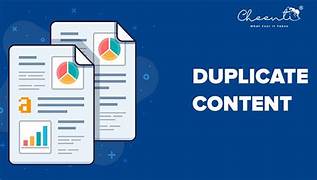Duplicate content can appear on a website for different
reasons. Sometimes the same content is accessible and
indexed under different URLs. This makes it difficult for
search engines to determine the best search result among
the different URLs. The result is keyword cannibalization.
The website cannot appear in the top rankings since
Google is unable to choose the best version.
You should therefore identify sources of duplicate content
on your website and rectify the errors as fast as possible.
Tips for identifying duplicate content:
- Check if your website is accessible with or without
www., HTTP, or HTTPS. If multiple versions are
accessible, use 301 redirects to redirect them to the
desired version. - Check if the same content is indexed in different
formats e.g., in print version or as PDF. - Test if your website automatically creates lists or
documents that generate duplicate content. - Check if your website displays similar content with and
without a “/” at the end of the URL.

What Is Duplicate Content?
Duplicate content refers to substantial blocks of content that either completely match or are remarkably similar to other content found on the same or different URLs.
Types of Duplicate Content:
- Exact duplicates: Identical content repeated verbatim across different URLs.
- Near duplicates: Content that is largely similar but has minor differences (e.g., city names, dates).
- Cross-domain duplicates: Content copied across different websites (intentional or unintentional).
- Internal duplicates: Content repeated within the same website (e.g., product pages, tag archives, printer-friendly versions).
- Scraped or syndicated content: When content is copied from one site and published on another without significant changes or proper attribution.
1. SEO Issues
- Keyword Cannibalization: Multiple pages compete for the same keyword, reducing each other’s visibility.
- Diluted Link Equity: Backlinks may be split across duplicates, reducing the authority of each page.
- Crawling Waste: Googlebot may spend time crawling redundant content instead of indexing fresh or important pages.
- Ranking Suppression: Google may not know which version to rank and may drop both.
- Penalties (in extreme cases): Google rarely penalizes for duplicate content unless it’s clearly manipulative or spammy.
2. Poor User Experience
- Repetitive or low-value content can frustrate users and increase bounce rates.
- Customers may see different prices or descriptions for the same product on different pages.
How to Identify Duplicate Content
Identifying duplicate content can be manual or automated. The approach depends on the scale of your website or project.
1. Manual Checks
Manual checking is possible for small websites or specific articles:
- Copy and Paste Search: Take a suspicious paragraph and search it on Google within quotes.
- Compare URL Variations: Check for HTTP vs. HTTPS, www vs. non-www, trailing slashes, and URL parameters.
Example:
Compare:
https://example.com/abouthttps://example.com/about/
If both show the same content, it may be a duplicate URL issue.
2. Use Online Duplicate Content Checkers
a. Copyscape
One of the most popular tools for checking if your content is published elsewhere.
- Input your URL and it scans the web for matches.
- Great for bloggers and writers ensuring originality.
b. Siteliner
- Scans entire websites for internal duplicate content.
- Provides a percentage of duplicate content across your site.
c. Grammarly or Quetext
- Built-in plagiarism checkers ideal for content writers.
d. Plagscan or Turnitin
- Academic and editorial plagiarism tools used for deep scans of content similarity.
e. SEMrush Site Audit
- Includes duplicate content checks along with other SEO issues.
f. Ahrefs Site Audit
- Highlights duplicate titles, meta descriptions, and content overlaps.
g. Screaming Frog
- SEO crawler that can identify duplicate content, metadata, and headers across pages.
3. Google Search Console (GSC)
Google’s own tool can help you spot content issues:
- Index > Coverage: Shows duplicate URLs or canonicalization issues.
- URL Inspection Tool: Tells you which version of a page Google considers canonical.
- Performance Reports: If similar pages are showing very different performance, it might be due to duplication.
4. Check for Canonical Tags
Use your browser’s “Inspect” tool or a plugin like MozBar to see if a canonical tag is in place:
html
CopyEdit
<linkrel="canonical"href="https://example.com/original-page"/>
If the canonical tag is missing or points to the wrong page, Google might treat the duplicate as separate content.
Common Causes of Duplicate Content
- CMS or Plaorm Issues
- Blog tags or archives create multiple versions of the same post.
- E-commerce plaorms create duplicate product pages via filtering or sorting.
- URL Parameters
- URLs with session IDs, UTM parameters, or tracking codes are seen as unique.
- Printer-Friendly Pages
- Print versions of articles can be indexed separately if not blocked.
- HTTP vs HTTPS
- Google may see them as separate sites if not redirected properly.
- Syndicated or Scraped Content
- Republishing without canonical tags or original attribution.
- Boilerplate Content
- Repeated legal disclaimers or footers on every page can dilute content uniqueness.
If you are visiting this post for the first time then click on this link to visit the table of content of the 30 Day’s Digital marketing journey Learn digital marketing in next 30 days
